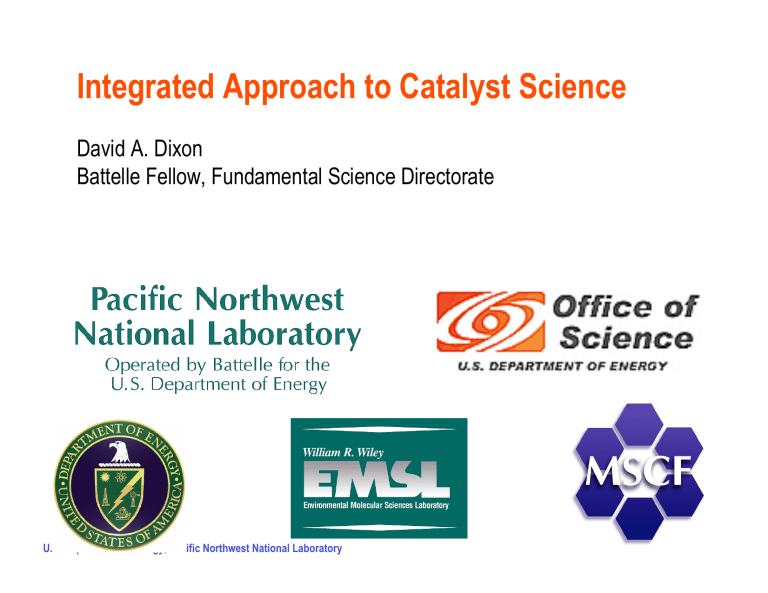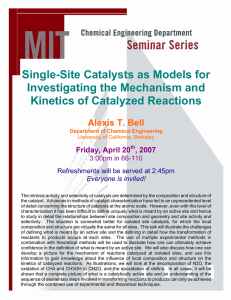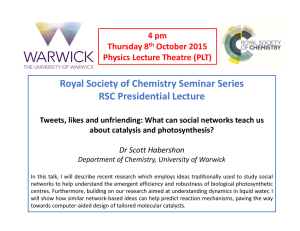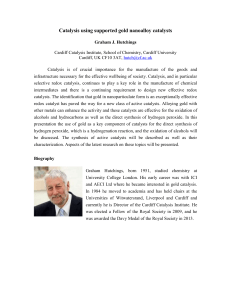Integrated Approach to Catalyst Science

Integrated Approach to Catalyst Science
David A. Dixon
Battelle Fellow, Fundamental Science Directorate
U.S. Department of Energy, Pacific Northwest National Laboratory
Grand Challenge is the precise control of molecular processes by using catalysts
¢ Synthesis and characterization (static and dynamic) of catalysts in pristine environments and in the more complex environments in which they operate. Controlled site synthesis in terms of atomic composition, cluster size, and spatial control of clusters. Must take advantage of high throughput methods.
¢ Development of in situ spectroscopies with chemical specificity, high temporal and spatial resolution.
¢ Development of advanced theoretical and computational methods required to describe complex catalysts quantitatively.
¢ Marriage of theory and experiment that will lead us to quantitative design principles and methodologies.
"CoMo"
Ru
Os
10
0
Fe
10
-1
Co
10
-2
10
-3
Mo
10
-4
10
-5
-0.8
-0.4
0.0
[ D ED E(Ru)](eV/N
2
)
0.4
U.S. Department of Energy, Pacific Northwest National Laboratory
Ni
0.8
Grand Challenge is the precise control of molecular processes by using catalysts.
¢ Computational methods hold the key to the fundamental understanding of catalytic processes thus enabling reliable catalyst design.
¢ Advanced characterization tools and in situ spectroscopies provide identities and structures of reactive intermediates leading to the elucidation of reaction mechanisms.
¢ Time-resolved methods will provide kinetics and dynamics of elementary processes. Experiment provides critical benchmarks for validating computational methods.
¢ Catalyst design will require quantitative information about transition states for critical reaction processes in catalysis. These are only accessible by computational methods.
¢ In order to truly advance the area of catalyst design, we will have to take advantage of advanced high performance computer hardware coupled with advanced theories and software/algorithms and fully
Whatʼs needed for chemical accuracy?
Example: the design of catalysts and separations systems?
Predict equilibrium chemistry: Selectivity
Change in K eq
@ 298 K
K eq
K eq
K eq
= 1 50:50
= 10 90:10
= 100 99:1
D
D
D
G = 0 kcal/mol
G = 1.4 kcal/mol
G = 2.8 kcal/mol
Predict accurate rates: Reactivity
Absolute Rates @ 298 K
Factor of 10 in rate @ 25 o C is a change in E a kcal/mol
of 1.4
True molecular design will require being able to do accurate calculations and/or being very clever!
U.S. Department of Energy, Pacific Northwest National Laboratory
Goals: Predict kinetics, thermodynamics, structure, & spectroscopy -
How do we replace experiments by getting the right answer for the right reason?
Small, gas phase molecule
Rate
Theories
Quantum statistical mechanics
Quantum simulation methods
H
3
PO
4
Basis sets
Multiple timescale dynamics
Fast methods
Phase transitions
New accurate
DFT methods
Solvation
& QM/MM Force fields
New correlation methods
Solid state Electron transfer theory
Relativistic effects
¢ Maintain accuracy by systematically eliminating approximations
¢ Go to larger systems by getting speed up of the computations
U.S. Department of Energy, Pacific Northwest National Laboratory
Interfacial & solution redox chemistry
Collaborative Access Team (CAT) Roadmap
Goal and Benefit
• Precise control of molecular processes by using heterogeneous catalysis
What is needed
• Truly integrated computational and experimental approach using state-of-the-art resources in high-speed computing and experimental catalysis synthesis, characterization and testing on an important and focused problem in catalysis to demonstrate what is possible.
Today’s State-of-the-Art
• Individual investigator approach using workstation-level methods and, at most, a few experimental approaches.
Timeline/Milestones
• In first 3 years, initiate studies of a particular catalyst problem and demonstrate integration of several components of the effort.
• In ~6 years, demonstrate full use of available capabilities in a fully integrated mode.
• In 10 years, have full demonstration of approach with at least one concrete example of development of the design of catalyst structures for specific control of activity and selectivity.
U.S. Department of Energy, Pacific Northwest National Laboratory
BES-sponsored workshop, “Opportunities for Catalysis in the 21 st Century”, held in May, 2002. Report concludes:
• “We are approaching a renaissance in catalysis science in this country” – there is an “unparalleled potential for making significant advances in this vital and vibrant field”;
• “Nowhere else can this revolution [in nanoscience and nanotechnology] have such an immediate payoff as in the area of catalysis”;
• DOE is “uniquely positioned to lead the revolution”;
• “An increased investment in this country… is essential”;
• “Through efforts that involve both experiment and theory”, the grand challenge is “to understand how to design catalyst structure to control catalytic activity and selectivity” – via
• “… close relationships between theoretical/computational and experimental researchers…”
• “… in-situ measurements … using state-of-the-art characterization methodologies…”
• “… a key goal for catalysis research is the integration of skills in a wide range of areas including catalyst synthesis, catalyst characterization, determination of reaction pathways and the dynamics of elementary process, and theoretical methods for predicting the structure of active centers and their catalytic properties.”
U.S. Department of Energy, Pacific Northwest National Laboratory
GRAND CHALLENGE
PROBLEM: the precise control of molecular processes by using heterogeneous catalysts – to be tackled by fully integrated, state-of-the-art computational and experimental approach
Synthesis, characterization and testing of heterogeneous catalysts
Synthesis, characterization and testing of heterogeneous catalysts
Demonstrate effective integration of a significant number of research elements (‘2-body’, ‘3body’, etc.)
Develop new synthetic approaches for the precise control of size, location and atomic specificity for supported
TMO catalysts
Utilize current EMSL state-ofthe-art structural and functional characterization techniques in order to demonstrate the capability to measure the local structure and atomic connectivity in inorganic solids. Couple this work with computational studies.
Demonstrate full integration of synthesis, characterization, computation, and realistic measurements on one example catalytic process – either acid-base or redox chemistry
Provide an adaptable capability for integrated catalysis research to the general user community via demonstrated precise control of oxidative dehrogenation or oxidation of alkanes by using heterogeneous catalysts
Utilize capability in an integrated way with other elements to accomplish Grand Challenge
Problem
Demonstrate capability for synthesis of supported TMO catalysts with controlled structures for the general user community.
Utilize methods to synthesize materials for characterization and testing, and that can be modeled computationally.
Demonstrate full use of these capabilities on materials specially synthesized materials coupled also with measurements of the dynamics of catalytic reactions and their corresponding elementary steps under reacting conditions for realistic system
Utilize capability in an integrated way with other elements to accomplish Grand Challenge
Problem
Synthesis, characterization and testing of heterogeneous catalysts
Adapt current EMSL catalyst testing facilities to measure reaction kinetics on model materials synthesized and characterized as above.
Objectives Phase I (3 years)
U.S. Department of Energy, Pacific Northwest National Laboratory
Demonstrate full use of these capabilities of these testing facilities coupled with synthesis and characterization efforts.
Measure kinetics that can be computed in theory effort.
Phase II (6 years)
Utilize capability in an integrated way with other elements to accomplish Grand Challenge
Problem
Phase III (10 years)
Computational approaches to the study of heterogeneous catalysts
Experimental technology development for heterogeneous catalysts
Objectives
Integrate computation with experimental approaches
Validate computational approaches on ODH and acid chemistry.
Develop new computational approaches
Perform accurate calculations for realistic heterogeneous catalysts in vacuum for ODH and acid chemistry(<1.0 kcal/mol thermodynamics, <50% error in reaction rates) to show possibility of guiding experimental work.
Utilize capability in an integrated way with other elements to accomplish Grand Challenge
Problem. Specifically, perform the computational design of a heterogeneous catalyst for ODH or acid chemistry or alkane oxidation
Identify and begin development of new experimental approaches needed to reach the goal of using a fully integrated approach to demonstrate precise control of molecular processes via heterogeneous catalysis
Phase I (3 years)
Incorporate one or more new approaches into arsenal of characterization and testing capabilities being used to pursue grand challenge goal.
Phase II (6 years)
Utilize capability in an integrated way with other elements to accomplish
Grand Challenge Problem
Phase III (10 years)
U.S. Department of Energy, Pacific Northwest National Laboratory
• Catalysis is both an exceptional intellectual challenge and critically important to the Nation. Catalysis is central to energy production and utilization, to chemical manufacturing, and to the minimization of environmental impact and it has been arguably the single most important agent for sustainable development in the developing world.
• DOE provides ~60% of the federal support for catalysis R&D and knows how to develop advanced resources and deploy them for the scientific community
• Innumerable reports have stated unequivocally that catalyst scientists need access to advanced research capabilities
• Complex Interfacial Catalysis focuses on chemical transformation in complex heterogeneous systems including systems involving immobilized homogeneous and biological catalysts.
U.S. Department of Energy, Pacific Northwest National Laboratory
Complex Interfacial Catalysis Capability
• Synthesis Module
• Controlled site synthesis
• Characterization Module
• Chemically specific information on nm to m m scale under process conditions
• Reaction Kinetics and Dynamics Module
• Probes of atomic motion, electron flow and energy flow in the catalyst, the reactant, the intermediates and the products
• Experimental Methodologies Module
• Development of new techniques: in situ and high throughput
• Computational Modeling and Simulation Module
• Development and application of advanced methods
• High Throughput Module
• Synthesis, characterization, testing, informatics and modeling
U.S. Department of Energy, Pacific Northwest National Laboratory




